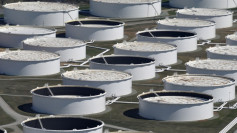Tycoons are encircling the troubled U.S. oil and gas patch, seeking to pick up on the cheap assets at a time when the state of the industry is scaring off other investors.
Sam Zell, the real estate billionaire, has partnered with Tom Barrack Jr., executive chairman of Colony Capital Inc., to purchase oil assets from firms in California, Colorado, and Texas at fire-sale prices trying to get ahead of a credit crunch.
Jerry Jones, the owner of Dallas Cowboys, said his Comstock Resources Inc. is in talks to acquire natural gas assets from the Chesapeake Energy Corp. fighting in Louisiana.
"I recently likened it to the real estate industry in the early 1990s, where you had empty buildings all over the country, and no one had the cash to play," Zell said on Bloomberg TV Thursday in an interview. "That's very much what we're seeing now."
The U.S. has become the world's largest oil supplier due to the fracking boom. Nonetheless, the stakeholders behind this development have little to show for it.
Following years of money churning and paltry shareholder returns, since 2014, independent oil and gas drillers have plummeted by more than 40 percent. Lenders become more discerning after much of the original boom has been enabled by easy money.
In the meantime, oil and gas prices remain depressed. That's a slowdown fueling. There has been a decline in the number of operating drilling rigs in the US, and some of the largest independent companies are reducing growth plans.
Chesapeake Energy Corp., once the second-largest U.S. natural gas company, warned shareholders last week that if weak oil and gas prices continue, it may not be profitable as a "going concern."
A sale of Louisiana Chesapeake's assets has been tied up as one of the few remaining options for a company that has become a poster child for the shale industry's promise and peril.
Jones, 77, who owns 73 percent of Comstock, said a deal could be valued at over $1 billion through his assistant. At a moment when all eyes are on the capacity of the company to pay its obligations, that would bring Chesapeake a cash infusion.
Of reality, when oil and gas prices have hit the bottom, that needs to be seen. Next year's predictions don't draw a nice picture, but some observers refer to a decrease in growth in U.S. output as a reason to believe that rates could move up by the end of 2020 and by 2021.





